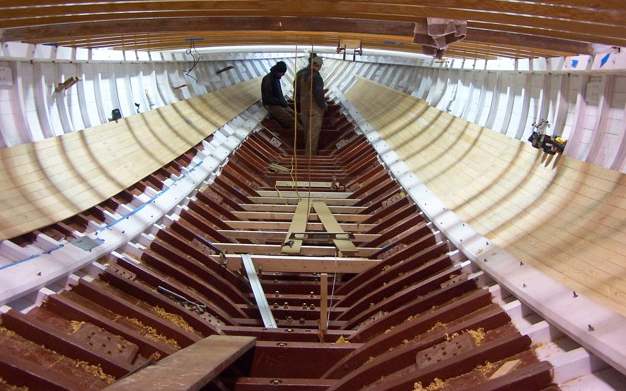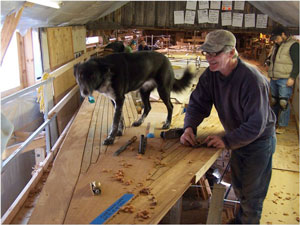Our restoration philosophy is based on several major principles.
Direct, productive labor and new materials are what add value to a boat. It is to everyone’s advantage that the highest possible proportion of our customers’ restoration budgets go into direct labor and new materials. Overhead costs, markups on materials and profits on subcontractor labor do not increase the value of a boat, so we have intentionally structured our way of doing business to minimize these expenses.

Consistency in the level of the work affords the greatest value added for the amount of money spent. By consistency we mean that money should be spent from the bottom up to avoid covering up problems or structural components nearing the end of their useful lifetimes with new work. We insist that the important structural items have the highest priorities when budgeting restoration expenditures. If funds are limited, the highest quality work and materials should go in the structurally most important locations; no temporary quality work should be covered up by permanent quality work.
We stick to the original construction design except when changes are clearly in order. We are dedicated students of the boatbuilding techniques of the great builders like Herreshoff and Nevins, who built many of the boats we restore. These boats have lasted remarkably well, and when restoring them, we go to great pains to duplicate the many successful techniques used in their construction. We use the original lines, offsets, and construction planks plans extensively and routinely to ensure that the boats we restore are returned to their original configuration and shape. We often devote considerable effort to researching a boat’s history.
However, we also recognize that the more innovative techniques of the great yacht builders were experimental and untested when many of the boats were built. We now have the benefit of almost of 100 years of in-service destructive testing on the types of boats we work on. If a technique worked, we follow it closely; if it didn’t work, we don’t hesitate to change it. Our changes usually involve other traditional methods, rather than radical modern technology.
We strongly advise against major repairs or restoration work if we feel that the work will not add to the boat’s value, if changes desired by the owner would not be appropriate for the boat, or if the work we do would inevitably have to be dismantled in a few years for access to underlying problems.
Restoration vs. Repair

We are essentially boatbuilders, rather than boat repairers. However, most of our work consists of major restorations of classic wooden sailing yachts. We look at a restoration as a limited boatbuilding job rather than as an extensive repair job. We do as much of a restoration as possible as if it were new construction, and we expect the results to be similar to a new boat in terms of strength, watertight integrity, appearance, and life expectancy. In general, the individual steps involved in building a new boat are considerably more efficient in terms of value added than the corresponding steps in repair work. It is more efficient to plank an entire side of a boat than to remove, fit, and replace scattered planks; to build a new deck than to repair an old one; to bend in a complete set of frames against new floor timbers, rather than removing and replacing half the frames or bending in sister frames.
The overall cost of completely restoring a sailboat to like-new condition is usually less than the cost of building an entire new boat, if the restoration is done efficiently. this is because a large proportion of the cost of a new boat is represented by things other than the cost of the hull itself: the work done to initially establish the shape, and the costs of the engine, the ballast, the rig and sails, the deck and interior joinerwork, the hardware, and other equipment. old boats, even when the y are in very poor condition, usually come with at least some and sometimes most of those things. in addition, many hull components such as keels, stems, sheer clamps, interior and deck joinerwork, etc. may be re-usable even when the deck, the frames, the floor timbers, and some of the planking, need replacement.
By combining the efficiency of new-boat construction wherever possible with the advantages of restoring existing hulls, we are able to produce restored original boats which are functionally equivalent to new boats for less than the cost of a new boat.
